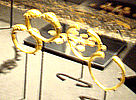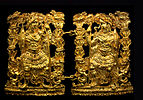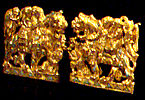Tillya Tepe
 Crown from Tomb VI (female owner) | |
| Alternative name | Tillya Tepe |
|---|---|
| Location | Afghanistan |
| Coordinates | 36°41′40″N65°47′22″E/ 36.69444°N 65.78944°E |
| Type | Burial ground |
Tillya tepe,Tillia tepeorTillā tapa(Persian:طلاتپه,romanized:Ṭalā-tappe,literally "Golden Hill" or "Golden Mound" ) is anarchaeologicalsite in the northernAfghanistanprovince ofJowzjannearSheberghan,excavated in 1978 by aSoviet-Afghanteam led by theSovietarchaeologistViktor Sarianidi.The hoard found there is often known as theBactrian gold.
The hoard is a collection of about 20,600 ornaments, coins and other kinds of artifacts, made of gold, silver, ivory, etc., that were found in six burial mounds erected for five women and one man, with extremely rich jewelry, dated to around the 1st century BCE-1st century CE.[1]The ornaments includenecklacesset with semi-precious stones,belts,medallionsand acrown.After its discovery, the hoard went missing during the wars in Afghanistan, until it was "rediscovered" and first brought to public attention again in 2003. A new museum inKabulis being planned where the Bactrian gold will eventually be kept.
The heavily fortified town ofYemshi Tepe,just five kilometres to the northeast of modern Sheberghan on the road toAkcha,is only half a kilometre from the now-famous necropolis of Tillia-tepe.
Dates and context[edit]

Several coins dated up to the early 1st century CE, with none dated later, suggest a 1st-century CE date for the burial. The coins found in the excavations belonged toTiberius(16-21 CE),Mithradates II(123-88 BCE), and the Yuezhi rulerSapadbizes(20 BCE - 20 CE).[2]The burial could correspond to Scythian or Parthian tribes dwelling in the area. More probably, they belonged to theYuezhis/ earlyKushansafter the fall of theGreco-Bactrian Kingdomand before the rise of theKushan Empire.[3]They correspond to a time when the Yuezhis had not yet encountered Buddhism.[3]
A silver coin was found in one of the tombs from the reigns of theParthiankingMithridates II,who ruledc. 123–88 BCE. The coin was found in tomb III, and was apparently held in the hand of the buried woman.
An imitation gold coin of Parthian KingGotarzes I(95-90 BCE) was found in the left hand of the woman in tomb VI. The fact that this coin is in gold, and not silver or bronze as is usually the case for Parthian coinage, suggest that this imitation was made for prestige purposes. The coin is counterstamped with the frontal depiction of what might have been a local chieftain. The counterstamp was added so as to not damage the portrait of the Parthian king, perhaps indicating some degree of dependency on the Parthians.
A gold coin was also found in tomb III showing the bust in profile of the wreath-crowned Roman EmperorTiberius.On the reverse is an enthroned, sumptuously draped female figure holding a spray and scepter. Coins of this type were minted in the city ofLugdunuminGaul,between 16 and 21 CE.[4]
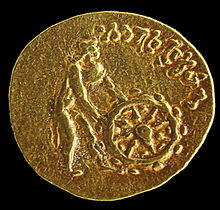
A Buddhist gold coin from India was also found in tomb IV (the male warrior). On the reverse it depicts a lion with anandipada,with theKharoshthilegend "Sih[o] vigatabhay[o]" ( "The lion who dispelled fear" ). The obverse shows an almost naked man only wearing an Hellenisticchlamysand apetasushat (an iconography similar to that ofHermes/Mercury) rolling a wheel. The legend in Kharoshthi reads "Dharmacakrapravata[ko]" ( "The one who turned the Wheel of the Law" ). It has been suggested that this may be an early representation of theBuddha.[5][7]
Finally, a very worn coin has been identified as belonging to the Yuezhi chieftainHeraios,orSapadbizes(20 BCE - 20 CE).[2]
It is thought that the site most likely belonged to theYuezhi(futureKushans).[5][8]Alternatively, it could have belonged to theSakas(AsianScythians),[9][10]who were later to migrate to India, known asIndo-Scythians,or to the EasternParthians.Several of the artifacts are highly consistent with a Scythian origin, such as the royal crown or the polylobed decorated daggers discovered in the tombs. Several of the bodies exhibited ritual deformation of the skull, a practice which is well documented among Central Asian nomads of the period.
Cultural influences[edit]
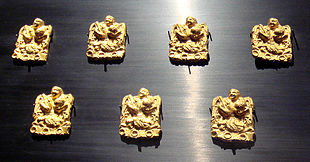
These pieces have much in common with the famousScythiangold artifacts recovered thousands of kilometers west on the banks of theBosphorusand theChersonese.
A high culturalsyncretismpervades the findings, however.Hellenisticcultural and artistic influences can be found in many of the forms and human depictions (fromamorinito rings with the depiction ofAthenaand her name inscribed inGreek), attributable to the existence of theSeleucid empireandGreco-Bactrian Kingdomin the same area until around 140 BCE, and the continued existence of theIndo-Greek Kingdomin the northwestern Indian sub-continent until the beginning of our era.
The artifacts were also intermixed with items coming from much farther, such as a fewChineseartifacts (especially Chinese bronze mirrors) as well as a fewIndianones (decorated ivory plates). This seems to be a testimony to the richness of cultural influences in the area ofBactriaat that time.
Loss and re-discovery[edit]
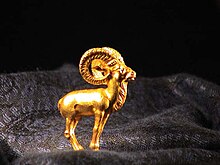
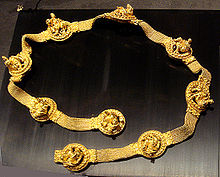
The hoard was thought to have been lost at some point in the 1990s, theNational Museum of Afghanistanhaving been looted numerous times resulting in a loss of 70% of the 100,000 objects on display.[11]In 2003, however, it was found in secret vaults under the central bank building in Kabul.
In 1989 following a committee decision, the last Communist president of Afghanistan,Mohammad Najibullahhad ordered the hoard moved from the museum to an underground vault at theCentral Bank of Afghanistanin Kabul. The doors of the vault were locked with keys which were distributed to five trusted individuals.[11]
In 2003, after the Taliban was deposed, the new government wanted to open the vault, but the keyholders (called "tawadars" ) could not be summoned because their names were purposefully unknown.Hamid Karzaihad to issue a decree authorizing the attorney general to go ahead with safecracking. But in time, the five key-holders were successfully assembled and the vault opened. Since then, the National Geographic Society has catalogued the collection, which appears to be complete – 22,000 objects. Also witnessing the re-opening were National Geographic Explorer and Archaeology FellowFredrik Hiebertand the archaeologist who originally found the hoard,Viktor Sarianidi.
Following an agreement between the Afghan government andFrance,the collection was evaluated and displayed internationally in an exhibition through the cooperation of several prominent museums and the National Geographic Society. Objects were on display from 2007-2009 variously at theMusée GuimetinParis,theNational Gallery of ArtinWashington DC,theAsian Art MuseumofSan Francisco,theMuseum of Fine ArtsinHouston,theMetropolitan Museum of ArtinNew York.[12]
Exhibitions[edit]
Some of the most spectacular finds were a part of the traveling exhibition titled "Afghanistan: Hidden Treasures From the National Museum, Kabul" or "Afghanistan: Crossroads of the Ancient World" which were first on displayed in December 2006 in France’sMusee Guimetin Paris. The exhibition supported by The National Geographic has also been to theNational Gallery of Artin Washington, D.C. from May 25 to Sept. 7th, 2008; from Oct. 24th, 2008 to Jan. 25th, 2009 the collection was at theAsian Art Museum of San Francisco;from February 22 to May 17, 2009 it traveled toThe Museum of Fine Arts,Houston then to theMetropolitan Museum of Art,New York from June 23 to Sept. 20th, 2009;Canadian Museum of Civilizationin Gatineau-Ottawa held the exhibition from October 23, 2009, to March 28, 2010;Bonn Museumin Germany from June 11, 2010 to January 2, 2011, from March 3, 2011 to July 3, 2011 theBritish Museumin London, and from November 2011 to March 2012,Museum of Ethnography,Stockholm.[13][14]From 22 March to 28 July, 2013, the exhibition was shown at theMelbourne Museum,followed by theQueensland Museumfrom 5 September, 2013 - 27 January, 2014, theArt Gallery of New South Walesfrom 6 March to 1 June 2014, and from July 5 to November 16, 2014 at theWestern Australian Museumin Perth and later toured at theTokyo National Museumfrom April 12 to June 19, 2016 and later from May 17 to June 17, 2017 at thePalace Museumin Beijing.[15][16]The exhibition also has toured theMuseum of Oriental ArtinTurin,Italy, andNieuwe KerkinAmsterdamalso saw displays.[17]Later on, the travelling exhibition continued at theHong Kong Museum of Historyfrom November 16, 2019 to February 10, 2020.[18]
By 2020, the displays brought in over 350 million Afs ($4.5 million) for Afghanistan. In 2021,Mohammad Tahir Zuhairannounced that the gold will be sent abroad for display and safekeeping.[19]
2021[edit]
In August 2021, the Taliban took control of Kabul, and the treasure is apparently missing yet again.[20]
Gallery[edit]
-
Statuette of winged figurine
-
Cloth decorations.
-
Bracelets.
-
Decorative stars. Tomb I.
-
Amoriniriding on fish, Tillia tepe. Tomb II.
-
Rings from Tillia tepe; the left one represents a seatedAthena.Tomb II.
-
Necklace. Tomb II.
-
"Kings with dragons". Tomb II.
-
Men in armor, in Greek fighting gear. Tomb III.
-
"Akinakes"polylobed decorated daggers. Tomb IV.
Notes[edit]

| Saka kurgans[21] | ||||||||||||||||||||||||||||||
|---|---|---|---|---|---|---|---|---|---|---|---|---|---|---|---|---|---|---|---|---|---|---|---|---|---|---|---|---|---|---|
|
||||||||||||||||||||||||||||||
- ^Srinivasan, Doris (2007).On the Cusp of an Era: Art in the Pre-Kuṣāṇa World.BRILL. p. 16.ISBN9789004154513.
- ^ab"Coins found in the graves include an aureus of the emperor Tiberius (16-21 A.C.), a gold minted coin which appears to be a local imitation of a Parthian coin (first half of the first century B.C.), a gold coin of undetermined Indian origin, a silver coin of Mithradates II (123-88 B.C.) and finally a Parthian silver coin of Phraates IV with the legend Sapaleizis, who is considered to be one of the Yueh-chih rulers." inSarianidi, V. I. (1980)."The Treasure of Golden Hill".American Journal of Archaeology.84(2): 130.doi:10.2307/504260.ISSN0002-9114.JSTOR504260.S2CID192970421.
- ^abSrinivasan, Doris (30 April 2007).On the Cusp of an Era: Art in the Pre-Kuṣāṇa World.BRILL. p. 16.ISBN978-90-474-2049-1.
- ^Sarianidi, Victor. 1985.The Golden Hoard of Bactria: From the Tillya-tepe Excavations in Northern Afghanistan.Harry N. Abrams, New York.
- ^abcMiyaji, Akira."Miscellanies about the Buddha Image":25–26.
{{cite journal}}:Cite journal requires|journal=(help) - ^Baumer, Christoph(18 April 2018).History of Central Asia, The: 4-volume set.Bloomsbury Publishing.ISBN978-1-83860-868-2.
- ^"Il semble qu'on ait là la plus ancienne représentation du Buddha, selon une modalité qui n'est pas encore celle de l'iconograhie boudhique traditionnelle" (French): "It seems this might be the earliest representation of the Buddha, in a style which is not yet that of traditional Buddhist iconography", inAfghanistan, les trésors retouvés,p. 280.
- ^"Judging by the richness of the grave goods, the cemetery belonged to one of the major Kushan princely families, possibly the richest and most influential, perhaps that of the founder of the Great Kushan empire". inSarianidi, V. I. (1980)."The Treasure of Golden Hill".American Journal of Archaeology.84(2): 130.doi:10.2307/504260.ISSN0002-9114.JSTOR504260.S2CID192970421.
- ^PUGACHENKOVA, G. A.; REMPEL, L. I. (1991)."Gold from Tillia-tepe".Bulletin of the Asia Institute.5:11–12.ISSN0890-4464.JSTOR24048280.
- ^Pankova, Svetlana; Simpson, St John (1 January 2017).Scythians: warriors of ancient Siberia.British Museum. p. 66, Item 25.
These graves at Tillya Tepe were initially regarded by the excavator as belonging to Yuezhi or Kushan nobility, but they are most likely to be tombs of a local tribal chief and his family who had strong connections with the Sakā cultures of Central Asia.
- ^abLawson, Alastair (1 March 2011)."Afghan gold: How the country's heritage was saved".BBC.Retrieved1 March2011.
- ^Fredrik Hiebert and Pierre Cambon, eds. Afghanistan: Hidden Treasures from the National Museum, Kabul. Washington DC: National Geographic, 2007.
- ^"Afghanistan:: 2011-11-12".collections.smvk.se.Retrieved2021-09-12.
- ^Afghanistan: mitt i världen.Eva Myrdal, Birgitta Hansson Sidvall, Etnografiska museet. Stockholm: Etnografiska museet. 2011.ISBN978-91-85344-63-5.OCLC938827240.
{{cite book}}:CS1 maint: others (link) - ^"Afghanistan: Treasures from the National Museum, Kabul|The Palace Museum".
- ^"Hidden Treasures from the National Museum, Kabul".
- ^Afghanistan: Hidden Treasures from the National Museum, Kabul(2008), pp. 18-19.
- ^"news.gov.hk - Afghan treasures to be exhibited".
- ^"Bactrian Gold Sent Abroad for Display, Safekeeping".TOLOnews.Retrieved2021-02-06.
- ^"Taliban announce hunt for ancient treasure".23 September 2021.Retrieved2021-10-02.
- ^Image file with complete data,Amir, Saltanat; Roberts, Rebecca C. (2023)."The Saka 'Animal Style' in Context: Material, Technology, Form and Use".Arts.12:23.doi:10.3390/arts12010023.
References[edit]
- Sarianidi, V. I. "The Treasure of Golden Hill."American Journal of Archaeology,Vol. 84, No. 2 (Apr., 1980), pp. 125–131."The Treasure of Golden Hill", JSTOR
- Sarianidi, Victor. 1990–1992. "Tilya Tepe: The Burial of a Noble Warrior."PERSICA XIV,1990–1992, pp. 103–130.
- "Afghanistan, les trésors retrouvés", Musée des arts asiatiques Guimet,ISBN2-7118-5293-8
- Afghanistan: Hidden Treasures from the National Museum, Kabul(2008). Eds., Friedrik Hiebert and Pierre Cambon. National Geographic, Washington, D.C.ISBN978-1-4262-0374-9.
- "L'Or De La Bactriane Fouilles De La Necropole De Tillia-Tepe." EnAfghanistan Septentrional,Leningrad, Editions d'art Aurora, 1985
Further reading[edit]
| History ofAfghanistan |
|---|
 |
| Timeline |
External links[edit]
- A photograph of the Tillya Tepe burial ground
- "An overview of the burials at Tillya tepe",Sara Peterson, 2018, fromAcademia.edu
- Afghanistan: Hidden Treasures from the National Museum,National Gallery of Art, Washington, DC
- Website dedicated toAfghanistan's Treasuresby Musée Guimet (Paris, France):Afghanistan, les trésors retrouvés
- "Afghanistan: Nation Protects Storied Bactrian Treasure",fromRadio Free Europe,June 9, 2006 – provides an overview.
- "Afghan golden treasure on display",fromBBC NewsSouth Asia, December 6, 2006
- "Lost Treasures of Afghanistan Revealed",fromNational Geographic,November 17, 2004
- "Parthian Aspects of Objects from Grave IV, Tillya Tepe",Sara Peterson, 2011 - 2012, fromAcademia.edu







